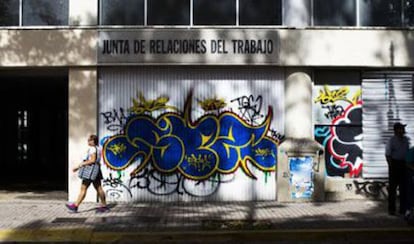Puerto Rico’s population dwindles
Number of people on the island is declining due to emigration to the US mainland and low birth rates

Puerto Ricans are either no longer born on the island or, if they are, do not stay, and when they leave, do not come back. Over the last five years, the number of Puerto Ricans living on the American mainland has surpassed that living on the island. As residents grow older, the population drops even more. The US territory is also facing an economic crisis that began in 2006 and has led to the most recent and largest wave of migration from Puerto Rico to the North American continent in the last century. Puerto Rican communities on the mainland are re-shuffling. While Nuyoricans – Puerto Ricans living in New York – are on the move, Disneyricans – islanders living in Florida – are settling down.
Between 2000 and 2010, Puerto Rico’s population dropped for the first time in modern history, by 2.2 percent, from 3.8 million to 3.7 million. The number of islanders living on the mainland quadrupled from 12 percent in 1950, during the era known as “The Great Migration,” to 55 percent in 2010. In the 1950s, about 300,000 people born on Puerto Rican soil or who had returned to the island moved to one of the 50 states. This influx of immigrants has grown over the last three years. According to a report published by the Pew Research Center this month, 144,000 Puerto Ricans moved to the mainland between 2010 and 2013 and the number of residents on the island dropped to 3.6 million.
Over the last five years, the number of Puerto Ricans on the US mainland has surpassed that living on the island
“This number is really impressive. It’s the first time we’ve been able to document this quantity,” says Jorge Duany, an anthropologist who has spent decades studying Caribbean migrations dating back to the 19th century. According to Duany, “this nation had a back-and-forth population.” Puerto Ricans came and went between the mainland and the island. “This back-and-forth movement has dropped. Starting in 1970, a significant number of people returned but now they only move in one direction. When this began, people thought it was more of the same thing. But we are talking about a very big ongoing exodus of people.”
Between 1990 and 2009, 1.8 million Puerto Ricans left the island for the mainland. Beginning in 1917, when Congress granted American citizenship to islanders, a good number of them settled in New York, the port with the best connections to San Juan. Later, between 1945 and 1965, half-a-million day laborers enlisted in the military or found employment as low-wage unskilled workers on American farms in what became known as The Great Migration. The next three generations of Puerto Ricans born on the mainland started to return to the island in 1970.
Just a decade later, the migrations resumed. Puerto Ricans now settle on the west coast and in the south in places such as California, Texas and Florida, as well as in the more traditional destinations of New York, New Jersey, Boston and Hartford. In 2006, Section 936 – the federal tax exemptions that boosted the Puerto Rican manufacturing industry and turned the island into the top choice for American investors – was repealed, causing an economic collapse islanders still feel today. This economic downturn has been one of the major causes of emigration in the last decade.
The birth rate in Puerto Rico is among the lowest in the region and in the country’s history
Those who leave the island cannot be replaced. The birth rate in Puerto Rico is among the lowest in the region and in the country’s history. “The birth rate was very high until the last mid-century,” Duany says. “There were 40 births per 1,000 residents, or five to six children per woman.” But then the country became a “laboratory” for testing birth-control techniques. Birth-control pills and sterilization arrived. And now the birth rate is 10 to 12 babies per 1,000 people or 1.7 per woman. “History tells us that when birth rates drop this low it’s very difficult to bring them back up,” the anthropologist says. “Unless the economy changes and a group of young immigrants comes in.”
There were 4.9 million Puerto Ricans on the American mainland by 2012. They are younger than their fellow resident islanders. About 300,000 of them live in central Florida – most of them in Orlando, Tampa and Miami. They are colloquially known as Disneyricans, Floriricans or Orlandoricans. The great migration to these cities began in the 1970s as the Disney theme parks sprang up and the tourism sector boomed.
“The socio-economic statistics for Puerto Ricans in Orlando are more favorable than in other parts of the United States and the community is in general substantially different from others,” Duany says. At least half of Disneyricans were born on the island and they are recent immigrants. Sixty-five percent of them consider themselves “white” and politically conservative. Their predominant language is Spanish and most of them are homeowners. On the other hand, two-thirds of New York’s Puerto Ricans were born in the United States. Half of them say they are “white” and they are traditionally Democrats. English is their first language and their economic situation is more precarious.
The power of Disneyricans in American politics has yet to reveal itself but analysts say it could be a decisive factor. “For years now, they have been saying that Florida’s Puerto Rican voters could decide the presidential and gubernatorial elections,” the anthropologist says. “We are talking about a sleeping giant who hasn’t fully woken up yet.”
Translation: Dyane Jean François
Tu suscripción se está usando en otro dispositivo
¿Quieres añadir otro usuario a tu suscripción?
Si continúas leyendo en este dispositivo, no se podrá leer en el otro.
FlechaTu suscripción se está usando en otro dispositivo y solo puedes acceder a EL PAÍS desde un dispositivo a la vez.
Si quieres compartir tu cuenta, cambia tu suscripción a la modalidad Premium, así podrás añadir otro usuario. Cada uno accederá con su propia cuenta de email, lo que os permitirá personalizar vuestra experiencia en EL PAÍS.
¿Tienes una suscripción de empresa? Accede aquí para contratar más cuentas.
En el caso de no saber quién está usando tu cuenta, te recomendamos cambiar tu contraseña aquí.
Si decides continuar compartiendo tu cuenta, este mensaje se mostrará en tu dispositivo y en el de la otra persona que está usando tu cuenta de forma indefinida, afectando a tu experiencia de lectura. Puedes consultar aquí los términos y condiciones de la suscripción digital.
Últimas noticias
From Andorra to Gibraltar, a black market for Ozempic exploits its success: ‘They’re the most sought-after products in the world’
Magnets in their heads: How some animals guide themselves using the Earth’s magnetic field
From Hungary’s Orbán to Chile’s Kast: How Trump helps turbo charge the far right
The brief rise and retreat of Generation Z in Mexico
Most viewed
- Why we lost the habit of sleeping in two segments and how that changed our sense of time
- Trump’s obsession with putting his name on everything is unprecedented in the United States
- Charles Dubouloz, mountaineering star, retires at 36 with a farewell tour inspired by Walter Bonatti
- The Florida Keys tourist paradise is besieged by immigration agents: ‘We’ve never seen anything like this’
- Living in a motorhome due to soaring housing prices in Madrid: ‘I got used to it quickly, but I don’t idealize it’









































